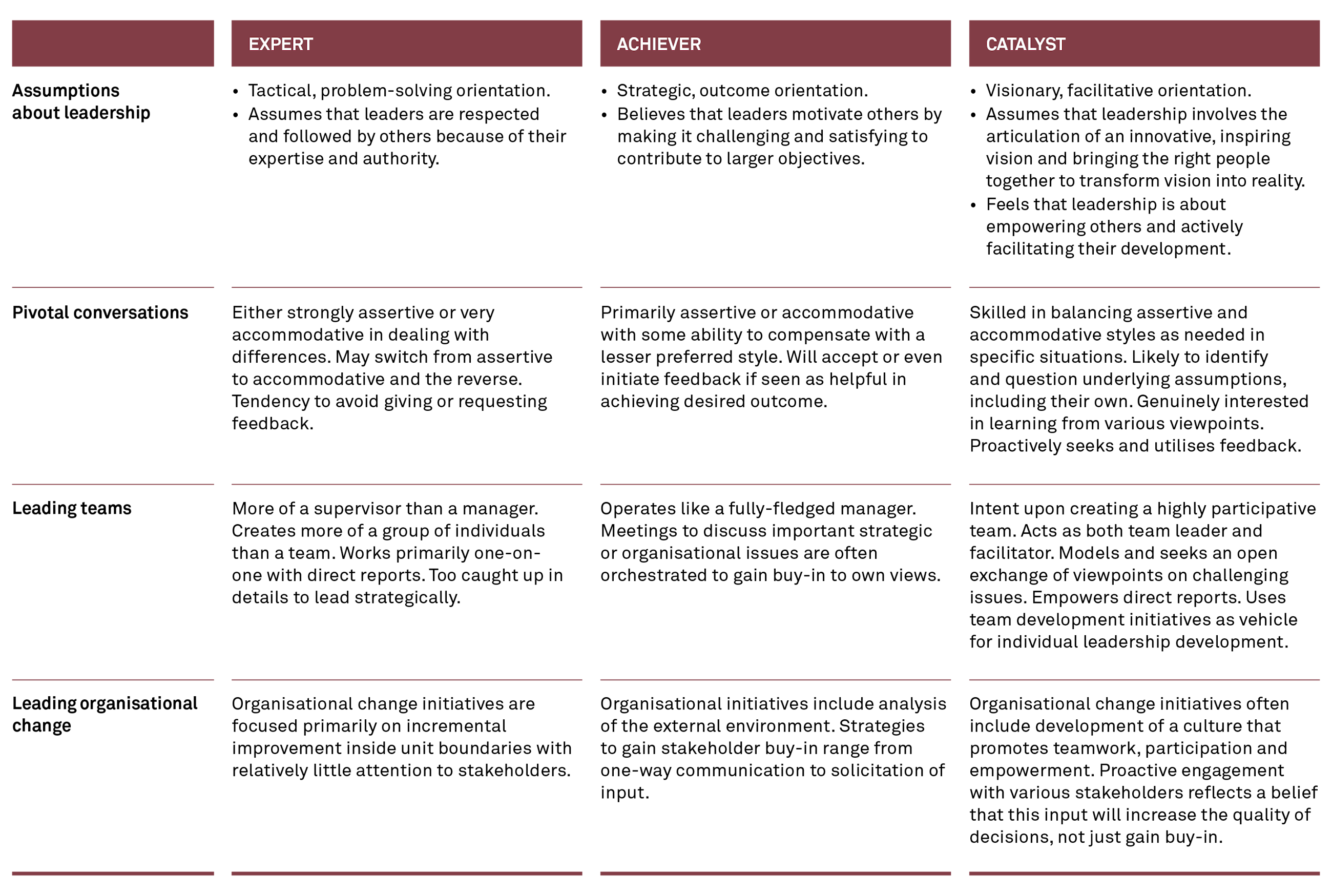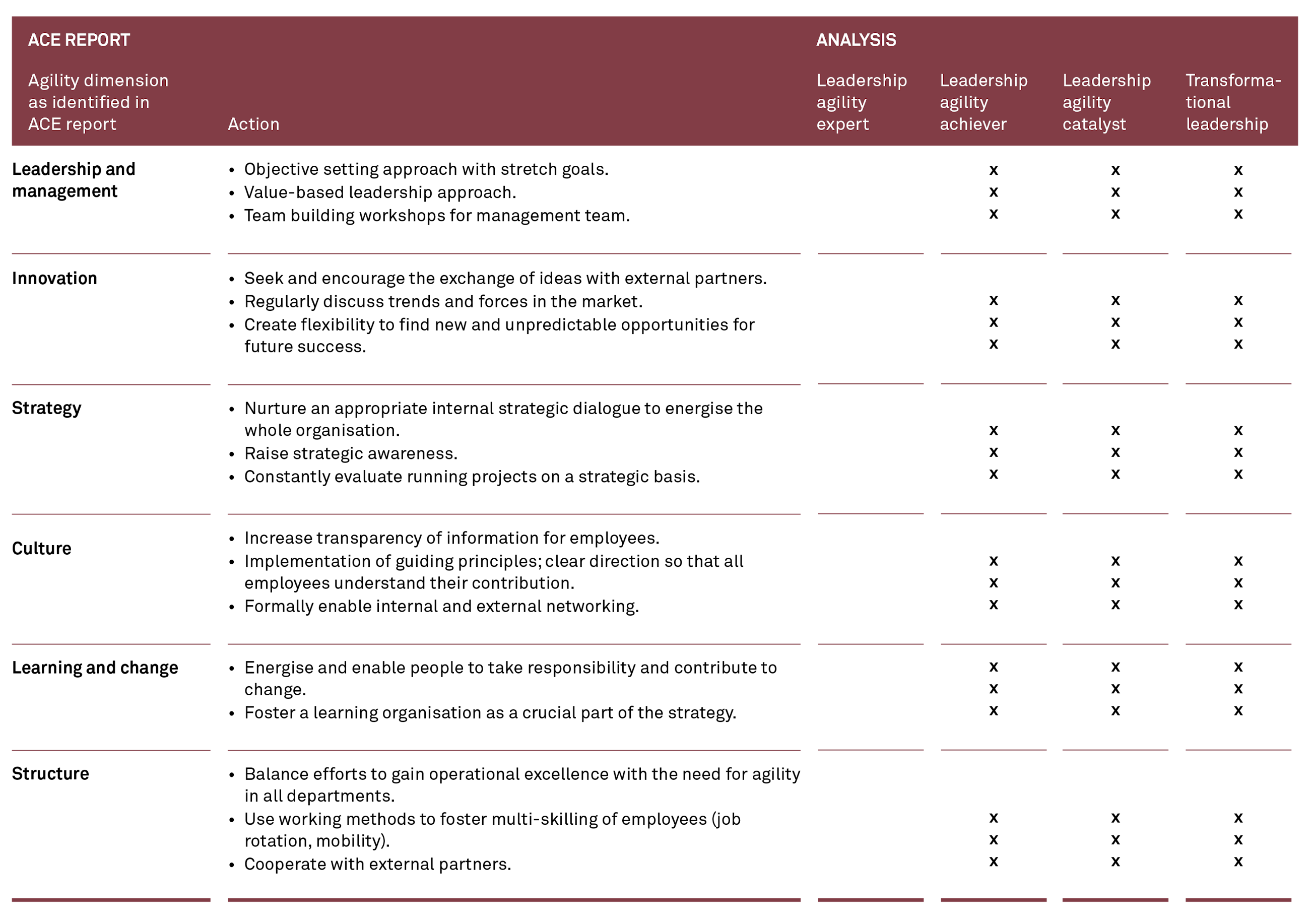13 November 2015
Organisational agility is considered a prerequisite for most organisations today. Business leaders are challenged in handling turbulence, uncertainty and constant changes in the market. What kind of leadership is needed to match the requirements of the agile context?
Research indicates a mismatch between traditional hierarchies and agility. Leaders seem to be more adapted to traditional contexts that rely on expertise and hierarchical position.
Below, we present a set of demands on the agile organisation and matches these demands with two research-based leadership models: transformational leadership and leadership agility.
Adapt and respond in order to survive
The world is changing due to a variety of reasons. Agility is a term frequently used in management today, indicating an increased need for organisations to rapidly react and respond to internal and external change. Technology connects people and makes information travel faster, spreading good and bad news at the speed of light. Global economy, turbulence and complexity are all factors affecting organisations, which create a need for organisations to adapt and respond in order to survive (Joiner, 2009; Joiner & Josephs, 2007; Ebrahimpour et al, 2012; ACE 2010). Jafarnejad (Jafarnejad, 2006) states that agility is the new paradigm, implying a change in attitudes, goals, work practices and management of organisations.
In a survey of European businesses, most organisations understood the need for agility in order to be successful in the future (Allied Consultants Europe, 2010). The vast majority of companies surveyed were not satisfied with their current level of agility and therefore aimed to increase it. 60% of the managers considered the level of agility needed to be “high” or “very high” in order to sustain their growth. 72% of the managers wanted to improve their organisation’s level of agility, and the majority of the public organisations considered their current level of agility to be “low” or “very low.” However, their future aspirations were very similar – approximately 60% of both private and public organisations aimed at a higher level of agility.
An agile organisation anticipates and reacts to change, is effective in reallocating resources and responds to customer needs. The authors of this article have noticed an increasing awareness of the emerging demands from the environment and marketplace in a variety of organisations during the past five years. The challenge is clear but as with all change situations, change is easier to prescribe than perform.
Hallencreutz (2012) found that managers use change management models to a low extent, even though they are informed of the benefits. In an effort to “get it done” and due to lack of incentives, focus and ability to apply theoretical models in practice, they dismiss theoretical aspects of change in favour of using a set of quick prescriptive steps or no structures at all. Hallencreutz found that knowledge is rarely transferred from consultants and experts on change management to managers who are supposed to master change management on top of everything else they have to deal with. Another reason for “failure” of most change initiatives is the lack of urgency. The “why” and a clear need for change are not communicated and result in a feeling that the change is not for real. Management need a roadmap as well as support to find new ways of acting and handling the turbulence. Among the dimensions affecting organisational agility positively, management and leadership appear to be the most crucial (ACE, 2010).
Since leadership and management are so crucial for organisational agility, and agility seems to be a desired condition for many organisations, the aim of this article is to analyse what leadership qualities are required in an agile organisation by comparing two theoretical frameworks: transformational leadership and leadership agility.
Methods
A theoretical comparison of the needs and demands in order to create organisational agility and the kind of leadership needed to enable this has been conducted. A short presentation of organisational agility is followed by an indication of what kind of leadership is needed. A model of desired leadership abilities in the ACE report is presented, and two frameworks of research-based leadership – transformational leadership and leadership agility – are described and matched with the leadership demands of organisational agility. The article concludes with a discussion of the analysis in the light of the author’s experience as a consultant.
Organisational agility
The concept of “agility” refers to alertness and flexibility as well as the ability to succeed in an unpredictable and changing environment. “Organisational agility” is a novel concept that lacks a precise definition in business literature (Ebrahimpour et al, 2012). The core meaning of organisational agility is the capability of a company to rapidly change or adapt in response to changes in the market. A brief review of available definitions of organisational agility (Crocitto & Youssef, 2003; Ebrahimpour et al, 2012; Gumusluoglu & Ilsev, 2009) show that they all consist of two parts. The first part states that organisations encounter a turbulent, volatile and unpredictable business environment. The second part makes it clear that organisations need to react and respond to these demands. Customers need more and varied products. This requires systems that are capable of quickly responding to customer needs (Veiseh et al, 2014). It also encompasses the ability to change the direction of strategic agendas and resources in an efficient and effective manner (ACE, 2010).
When the speed and pace of development in the market are high, employees must be encouraged to participate in innovation, pay attention to events affecting the business and focus on creating customer value rather than “doing things the right way.” There is a need to establish fast organisational learning, adaptable organisational infrastructure with a scalable workforce, continuous learning and knowledge sharing (Crocitto & Youssef, 2003). Businesses need to focus on solid principles such as customer focus, cooperation, mastering change and valuing people and information (Ebrahimpour et al, 2012).
In order to handle competition, a variety of methods and philosophies are used. El-Tawy and Gallear (2006) describe the connection and interdependency between Lean principles and agile philosophy in supply chains in the manufacturing industry, and they reach the conclusion that both are needed to create an efficient business. However, as highlighted in Crocitto and Youssef’s (2003) article, the focus on the human side of organisational agility is often underestimated or polarised. Some researchers tend to focus on production and operations management (Dean & Bowen, 1994; O’Connor, 1994), neglecting issues of culture, organisational context, communication and leadership. General management theorists focus on the people dimension within a total quality management framework without considering the mathematical aspects or human technology aspects of agility. The challenge is to embrace both technical and human aspects (Crocitto and Youssef, 2003).
Being agile as an organisation has a positive correlation with performance. Ebrahimpour et al (2012) looked at six agility capability variables (responsiveness, flexibility, competency, quickness, agility capabilities, company performance) in relation to company performance indicators (sales compared to competitors, company market share, customer attraction, customer increase, new products to market, ROI, net profit, company performance, agility capabilities) and found that there is a positive and significant relationship between agility, capabilities and corporate performance in manufacturing companies. Another indication of the link between organisational agility and success was demonstrated in a report where market leaders were highly agile according to a performance index, competitiveness and reactivity (ACE, 2010). The response to changes in the marketplace and customer needs seemed to be one of the most important influencers for success. The organisations with a high level of organisational agility not only experienced strong performance and success, they also had a market leading position in the majority of cases (MIT Sloan School of Management on Business Agility & IT Portfolios, 2005).
Leadership in organisational agility
Leadership needs to adapt to organisational agility, which can be done in several ways. Crocitto and Youssef (2003) underline the human side of organisational agility and the need for elimination of traditional hierarchies. Most managers come from a traditional hierarchy, and therefore it may seem unappealing to let go of status and position when the hierarchical position has been earned over many years. Leadership based on a transformational and value-based leadership approach is suggested (Veiseh et al, 2014; Kuhnert & Lewis, 1987; Gumusluoglu & Ilsev, 2007). Leaders must engage and motivate all employees so that they can contribute to the development of the organisation. Everyone should feel an obligation to contribute, take on responsibility and understand their importance in making the organisation develop and sustaining the development. Creating an agile culture requires leaders to be skilled in a number of “agilities” in order to handle the above-mentioned arena of turbulence and complexity (Joiner, 2009). The ability to step back and “zoom out” to gain a broader perspective and then “zoom in” again to decide what to do next is emphasised as a key practice for agile leaders.
Six dimensions of organisational agility
Organisational agility has six dimensions in which there is emphasis on the internal and human aspects (ACE, 2010). These six dimensions can be seen as demands on leaders in which they need competency (see table 1). Leadership and management have been identified as the most important enablers of organisational agility.
Within leadership and management it is essential that leadership stimulates the capacity and readiness of all employees to think “outside the box” by stretching goals in a way that challenges the “business as usual” mindset. People have to think in a dramatically different way to reach ambitious goals. Building leadership on a firm value base means that all managers must embody this in their daily actions and behaviour and convey it to all employees. The core of innovation is to put the exchange of ideas on the agenda and openly discuss trends and forces in the market with employees and external stakeholders that will positively increase everybody’s learning curve and improve the propensity to innovate within the organisation (ACE, 2010). Strategy involves creating an internal dialogue to help improve the level of agility within the business and raising the strategic wareness, which in itself has a positive influence on agility. Culture is about being transparent with information, giving clear direction and allowing people to contribute to development and learning. Learning and change mean that everybody has to take responsibility for and contribute to change. The challenge of structure is to balance operational excellence with agility and to possess the ability to reallocate resources when a business opportunity arises. Networking externally and internally is also vital while encouraging job rotation and multiskilling across the organisation.
Analysis
The six dimensions and enablers of organisational agility will be taken as a point of departure in the next step. An analysis regarding the three levels of leadership agility and transformational leadership will be conducted with the goal of matching specific capacities within each leadership style to the demands on leaders carrying out the tasks needed for organisational agility. We start by introducing the two theoretical frameworks.
Transformational leadership
Looking at the demands on leadership when dealing with organisational agility, transformational leadership is one of the dominating leadership models mentioned in international journals in recent decades (Larsson & Eid, 2012). The concept of transformational leadership was introduced by James MacGregor Burns (1978). According to Burns, transformational leadership can be seen when the leader elicits motivation and willingness to contribute rather than mere compliance. It involves shifts in the beliefs, the needs and the values of followers (Kuhnert & Lewis, 1987). Leaders and followers encourage each other to advance to a higher level of morality and motivation. Through the strength of their vision and personality, transformational leaders are able to inspire followers to change expectations, perceptions and motivations to work towards common goals.
Unlike the transactional approach, it is not based on a “give-and-take” relationship, but on the leader’s personality, traits and ability to make a change through example, while articulating an energising vision and challenging goals. Transforming leaders are idealised in the sense that they are a moral example of working towards the benefit of the team, organisation and/or community. Burns theorised that transforming and transactional leadership styles were mutually exclusive. Later, researcher Bernard M. Bass expanded upon Burns’ original idea to develop what is today referred to as Bass’ Transformational Leadership Theory (1985). According to Bass, transformational leadership is defined based on the impact that it has on followers. Transformational leaders, Bass suggests, garner trust, respect and admiration from their followers.
The effects of a transformational leadership style on organisational agility have been studied recently. In organisations facing rapid, instant and unpredictable changes along with special orders and expectance of a high level of personalised customer service, transformational leadership had an effect on organisational agility and a mediating role of creativity (Veiseh et al, 2014). Veiseh et al (2014) ranked the effects of the transformational leadership style on organisational agility and found a positive correlation between the four dimensions of transformational leadership, hopeful influence, inspirational motivation, intellectual encouragement and personal consideration.
Leadership agility
Leadership agility is a framework adapted for environments characterised by rapid changes, turbulence, uncertainty and complexity. Stephen Josephs and Bill Joiner presented results and conclusions of an in-depth study on leadership in their book Leadership Agility in 2007. The concept identifies both crucial competencies for a leader to be agile and five different levels of leadership agility, each representing a distinct set of mental and emotional capacities. The framework of leadership agility builds on theories of adult development where the core idea is hat it is possible for people to continue to grow and mature in adulthood, which means that they develop qualitatively different ways of thinking, talking and acting (Commons, 1989, 1990; Kegan, 1982; Kohlberg, 1981; Loevinger & Blasi, 1976).
Empirical studies show that leaders can expand their ability to understand broader perspectives, become more receptive to feedback, have a more visionary view on leadership, become better at resolving conflicts and learn the benefits of developing subordinates (Cook-Greuter, 2005; Dawson & Heikkinen, 2009; Joiner & Josephs, 2006; Kegan, 1994; Kegan & Laskow Lahey, 2009; Kuhnert & Lewis, 1987; McCauley, Drath, Palus, O’Connor & Baker, 2006; Torbert, 1994; Torbert & Fisher, 1992; Torbert, 2004; Torbert & Rooke, 1998, 2005; Valcea, Hamdani, Buckley & Novicevic, 2011).
The way people make meaning stems from their inner mental and emotional capacities. A more mature adult makes meaning from a more balanced platform where own and other people’s views can be evaluated. The overall demands on leaders are aimed at a more advanced level of leadership agility, thus allowing the leaders to bring in new perspectives, be curious and interested in involving others, let go of control of details, be less focused on power due to hierarchical position, present inspiring long-term goals, be visionary and handle uncertainty and change.
The three most common leadership styles are presented briefly: the expert, the achiever and the catalyst (Joiner & Josephs, 2006). Expert leaders are most effective in stable organisational environments. Leaders rely on authority and expertise. Their focus is tactical, and they rarely attempt to influence matters beyond their own authority. They have a strong problem-solving orientation and are strongly motivated to develop their own technical and functional expertise. Achiever leaders are most effective where success requires periodic crossfunctional changes in strategy. They lead by motivating others to contribute to larger outcomes. They have a strategic focus and excel at cross-functional problem-solving. They are motivated to develop the competencies needed for management and leadership. Catalyst leaders are most effective in rapidly changing organisational environments, requiring significant coordination across multiple boundaries. They provide visionary leadership while engaging various stakeholders in collaborative dialogues and creative problem-solving. Focus is on developing empowered organisations and teams capable of sustaining success, which fosters both professional and personal growth.
The Leadership Agility Model describes managers’ leadership behaviours in three different arenas: organisational level, team level and one-to-one level. The table below provides a brief explanation of the three arenas for the most common leadership levels: experts, achievers and catalysts. Furthermore, the table describes the leaders’ different assumptions about leadership. It is clear that leaders at different levels look at their leadership task in quite different ways.
Analytical comparison
Expert leaders are not capable of acting in favour of organisational agility (see the table below). This interpretation is based on the fact that an expert leader has a tactical and problem-solving focus which is better matched with an organisational environment that works with existing and stable strategies and with an ambition to make incremental improvement rather than respond to volatility and rapid changes. Expert leaders do not find it useful to engage people in collaborative dialogues. They tend to work on a one-to-one basis and do not involve their assistant managers in common goal setting or visionary work.
The table below describes how the leadership style would handle the demands of a specific agility dimension: some certainty (small x) or most likely (big X). If there is no x, the analysis found no likelihood of the leadership performed to match or meet the requirements of the agility dimension.
Achiever leadership style is marked with a small x in the table below, which means that they are capable of carrying out the actions indicated as drivers of organisational agility. As shown in the table, the x is smaller for an achiever leadership style than for a leader at catalyst level. The reason for this is that achiever level leaders have a reflective capacity covering their own development and personal experience and change. The achiever strives to learn from experience and to have a sense of empathy and insight into other people’s way of thinking and acting. The achiever communicates and relates to others in a more nuanced way and relies on a system of values as a result of experience and reflections on life. The achiever can work and plan on a more strategic, long-term level and look for outcomes rather than ”doing the right things”, as the expert does, and is often respected for not putting their own interests above the interests of the organisation.
At the catalyst level, a fully-fledged leader with all the prerequisites for building organisational agility emerges. The catalyst is capable of creating a context of sustained organisational achievement. They set goals beyond the current boundaries and often involve others in problem-solving and innovation. A catalyst leader can let go of control and deal with uncertainty and change without being too anxious.
The advantages of a catalyst leadership style, when the demands are such as indicated in the agility dimension, are obvious. The catalyst possesses the ability to create new contexts where people can use their creative potential by participating in innovation and problemsolving. They create situations where people feel motivated, valued and eager to contribute. The achiever can bring people to engage in common tasks on a long-term basis, whereas the catalyst leader sets direction and lets people contribute by creating opportunities for exchange of ideas and dialogue. The catalyst leader is clearly a facilitator of creativity; a leader who makes it fun and safe to contribute.
When comparing transformational leadership with the different leadership styles in leadership agility, we find that there are similarities between the achiever and catalyst leadership styles and what is emphasised in transformational leadership. Transformational leadership aims at shifting the followers’ beliefs, needs and values, not just creating compliance (Kuhnert & Lewis,1987).
Consulting experience
The authors of this article have as consultants and teachers met groups of managers in organisations with an explicit need for organisational agility where the probable level of leadership was mainly at an expert level. How could we suggest this without having executed any kind of “measurement” or tested the managers? This is of course a valid remark. However, meeting managers in exercises and discussions indicates quite well how they create meaning, look at the world, perceive themselves as leaders and others as contributors to problem-solving of their challenges.
According to research, 45% of managers function at expert level, 35% of managers function at achiever level, and only 10% of managers at catalyst level or above (Joiner and Josephs, 2007). 10% are even less developed and were found working as supervisors in less complex organisations. Many managers were recruited and trained under different and more stable conditions where the expert leadership style was more suitable. Many leaders have built their career on a leadership style that is less efficient in the new turbulent word and struggle to handle their tasks with tools and strategies that served them historically.
A conclusion is that demands on leaders are challenging in the current situation – the experts seem to be the dominating group of leaders, although it is clear that achievers and catalysts better match the demands on modern leaders.
During a year-long assignment where a leadership development programme was launched, aiming at increasing the collaborative and innovative skills in a quite traditional organisation, author Eva Norrman Brandt had the opportunity to meet 140 managers, most of whom held university degrees and were experts in their line of business. The way this organisation worked was traditionally “silo”-oriented work within specific areas of knowledge and competency. The new challenge was to work cross-functionally in collaboration with other departments and grow by making innovations with people inside and outside the organisation. To meet these challenges, another way of leading was clearly needed, so the CEO of the company decided to build a leadership training programme aimed at a higher degree of leadership agility.
When presenting and running this programme, we estimated that approximately 60% of the managers in the programme had a leadership style corresponding to expert level. This became quite clear when we discussed the human side of leadership, for example when we talked about self-reflection and the psychological side of leadership. Furthermore, when we made an exercise pinpointing different leadership styles in the leadership agility framework, many felt threatened and criticised when the need for a different leadership style to meet the demands on leadership in an agile organisation was addressed. One possible reason for the resistance was that these managers felt uncomfortable when realising that they represented a kind of leadership that needed development. Those who intuitively found themselves being an expert leader felt challenged and even criticised. This experience was valuable to us as leadership consultants – it raised the question “how do we help people to increase their level of leadership agility without feeling criticised and inadequate?” People do not change and develop if they feel criticised and inadequate. Subsequently, we found a way to deal with this – an effective way to lower the resistance we met.
We “zoomed out” and emphasised the context, the changes and the new demands on leaders today and tomorrow. We stressed that leaders were usually recruited on the basis of their expertise and that most leaders in their industry relied on a deep level of knowledge in their areas of expertise. Without that deep level of knowledge and expertise, they were unlikely to be accepted as leaders. Their careers had been built on their way of acting and leading so no one had been wrong. Now we turned to the present and future situation, an entirely different arena where demands on leaders and subordinates have changed completely. In this new context, additional competencies and mental maps that we could assist them with were needed. We gained approval and established a working alliance with even the most reluctant and angry managers. As a sign of recognition, one of them approached us at the end of this year-long leadership programme and said “you saved my health by giving me an insight into the need for involving others and letting go of control.” This leader, who was a typical expert with responsibility for “everything” and with a demand on himself for having detailed knowledge of every area of his department, realised that delegating, relinquishing control, trusting others and involving several stakeholders not only benefited him but also improved his line of business.
Discussion
The main conclusion is that organisational agility requires that leaders in strategic positions exhibit transformational leadership qualities, or leadership agility, at a developed achiever level or – even better – at a catalyst level.
As far as methodological considerations are concerned, the succinctly analytic comparison has certain limitations. A more thorough comparison would ideally rely on richer empirical material with more and lengthier examples. A complementary approach would be to test leaders on measurements aimed at assessing transformational and developmental aspects of leadership in order to see how these correspond to leaders’ thoughts and actions. This has been outside of the scope of this article but is an important future research area.
The comparison between two models showed that the strength of the Leadership Agility Model is that it provides a more detailed description of capacities and capabilities connected with each stage (expert, achiever, catalyst). Transformational leadership is described in more general terms, whereas the Leadership Agility Model depicts more specific actions in several areas of leadership. The result of this study also confirms previous studies, which found that transformational leadership can be compared to achiever level agility or higher (Kuhnert & Lewis 1987; Eigel & Kuhnert, 2005).
The result raises the question of how to handle the gap between leadership abilities and the required demand of organisational agility. When employees are not up to the task, can we ask them to be personally involved in personal development (Kjellström, 2010)? To create a leadership structure in an organisation is the responsibility of organisations as well as individuals. If a leader is in over his or her head, it is not solely a problem for the individual to handle, nor is it a fact to accept, it is also the result of inferior recruitment by organisations (Kjellström, 2009). Further research is required on the effectiveness of leadership development and how organisations can be structured to respect people where they are. The Leadership Agility Model explains that acquiring a higher level means a developmental journey over time. It is not a quick-fix but it is not impossible if the individual is aiming at personal development and takes on the task of expanding his capacities.
The challenge is to attract leaders with an interest in personal development, which may not have been the most important characteristic among business leaders who traditionally were recruited and who focused on other merits such as expertise in their field of competency. A recently released report from UK-based consultancy Harthill Consulting in collaboration with PwC indicates the need for leaders at a “strategist level” to handle complexity and turbulence in the economy, society and business environment. This report is based on research and practical work with leaders from different industries.
The conclusions in the report are similar to what has been emphasised in this article. There is a need for leaders at a more advanced level of leadership agility or with a transformational leadership approach. The need for a new and different kind of leadership is acknowledged today, but recruitment and training of leaders need to be more adapted to and aligned with the new demands. Research shows that business schools to a small extent encourage personal development (Valcea et al, 2011). This should probably be reevaluated, since the demands on leadership should also be met with a readiness to support and develop leaders in an appropriate way.
There is a need for further research within the area of organisational agility and leadership. In organisations where agility is needed but only a relatively small number of leaders embrace the leadership style most suitable for the new reality, there should be attention directed to the need for leadership agility. Recruitment and training aimed at increasing the number of agile leaders would make a difference.







